Marked by endless lines of people queuing up in front of stores as early as midnight to seize the best deals, Black Friday has long served as the official start of the holiday shopping season.
With the advent of ecommerce, its online counterpart Cyber Monday came onto the scene, becoming another steady revenue source for the retail industry. But due to the global pandemic in 2020, retailers were worried about how two of the year’s biggest shopping days would fare.
In this Black Friday vs. Cyber Monday statistics overview, we’ll find out how they performed in terms of sales and total revenue. We’ll also take a closer look at the discounts retailers provided in 2020 and examine the most recent trends regarding these two major shopping holidays.
Top Black Friday vs. Cyber Monday Statistics (Editor’s Choice)
- Online shoppers spent $9 billion on Black Friday in 2020.
- With $10.8 billion in revenue, Cyber Monday 2020 was the largest one to date.
- US online sales during Cyber Weekend 2020 totaled $34.4 billion.
- 41.1% of the Cyber Weekend online revenue in 2020 came from mobile sales.
- Brick-and-mortar sales during Cyber Weekend 2020 declined by 23.9% in 2020.
- Curbside pickups on Black Friday increased by 52% compared to 2019.
- The discounts on Cyber Monday 2020 went up to 50%.
- Most US consumers used cards to pay for their Black Friday purchases in 2020.
Cyber Monday vs. Black Friday Statistics: The 2020 Overview
1. Online shoppers spent $9 billion on Black Friday in 2020.
(CNBC)
On November 27, 2020, US shoppers spent around $9 billion on online purchases alone. This marked a 21.6% increase from the $7.4 billion online Black Friday sales generated last year. The COVID-19 pandemic in 2020 forced more people to stay at home and shop on the internet. As a result, this Black Friday became the second biggest online shopping day in US history.
The average spend in 2020 totaled $27.50 per person, Black Friday ecommerce stats reveal. What’s more, US online shoppers were spending $6.3 million per minute on Black Friday.
2. With $10.8 billion in revenue, Cyber Monday 2020 was the largest one to date.
(Forbes)
Looking at Black Friday vs. Cyber Monday sales revenues in 2020, the latter shopping holiday came out on top. Cyber Monday 2020 topped its record of $9.4 billion from the previous year, posting a 15.1% revenue increase. Also, compared to Cyber Monday statistics from 2018, when online retailers generated $7.9 billion in revenue, online sales were up by an impressive 36.7%.
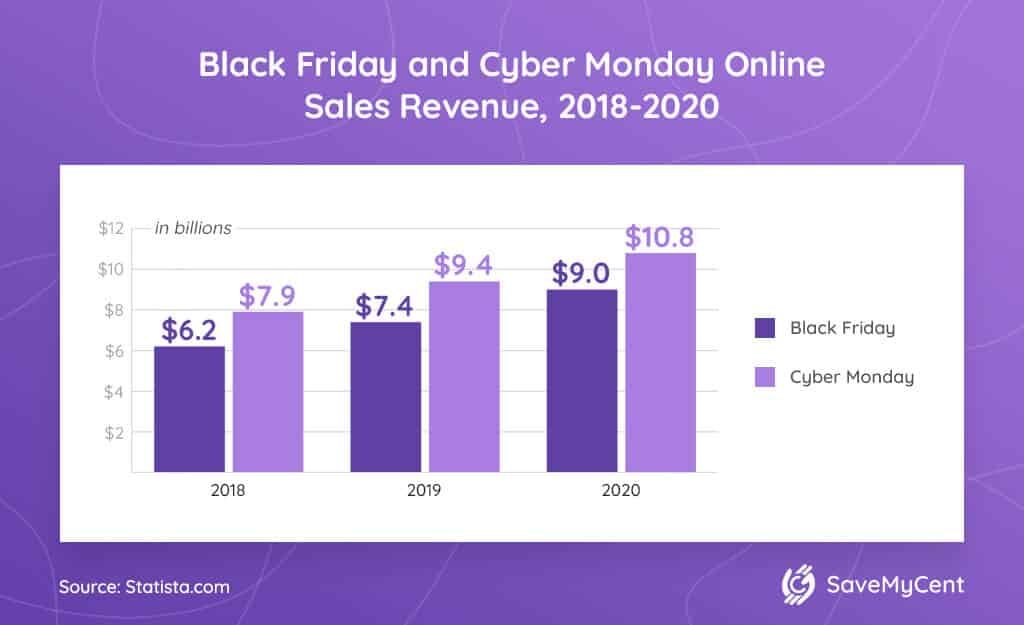
3. 25% of the total Cyber Monday revenue was generated during just four hours.
(Forbes)
Interestingly, between 7 pm and 11 pm PST alone, US Cyber Monday online sales generated upwards of $2.7 billion. It’s easy to understand why — with the biggest deals on Cyber Monday set to expire soon, online shoppers rushed to take advantage of them before it was too late.
All this helped Cyber Monday 2020 become the biggest online shopping day ever in the United States. While expected, it was still somewhat surprising considering that many retailers started offering holiday discounts as early as mid-October to boost their sales amid the pandemic.
4. US online sales during Cyber Weekend 2020 totaled $34.4 billion.
(Adobe, Statista)
The revenue during Cyber Weekend 2020 — which included Black Friday and Cyber Monday — was up 20.7% from $28.49 billion in 2019. In addition to $9 billion on Black Friday and $10.8 billion on Cyber Monday, online retailers generated $5.1 billion on Thanksgiving — up 21.5% from $4.2 billion the previous year. Online sales were also up on Small Business Saturday, the day after Black Friday, rising by 30.6% from $3.6 billion in 2019 to $4.7 billion in 2020.
5. Online holiday shopping revenue reached $106.5 billion by Cyber Monday.
(Adobe)
In previous years, online retailers wouldn’t reach the $100 billion mark before mid-December. But thanks to the success of Cyber Monday and Black Friday online shopping in 2020, they exceeded that milestone by the end of November. Between November 1 and November 30, Americans spent $106.5 billion on online holiday shopping — a 27.7% increase year-over-year.
6. 41.1% of the Cyber Weekend online revenue in 2020 came from mobile sales.
(Adobe, Forbes)
The steady growth of mobile commerce also reflects on holiday shopping. In 2020, 40% of the entire online spend on Black Friday came from smartphone users. Similarly, Cyber Monday statistics show that mobile sales accounted for 37% of the total online revenue that day. Overall, the share of mobile sales during the five-day Cyber Weekend was up by 7.4% from 2019.
7. Brick-and-mortar sales during Cyber Weekend declined by 23.9% in 2020.
(Forbes)
As online sales increased, in-store purchases saw a significant decline. Amid the pandemic, physical stores lost almost a quarter of their revenue from the same period in 2019. In addition, brick-and-mortar retailers saw a 23% decline in foot traffic on Cyber Monday 2020. But while this decline affected the retailers, it had no impact on Black Friday or Cyber Monday revenue.
8. Online grocery shopping on Black Friday 2020 rose by 397% from the October daily average.
(CNBC)
Even grocery stores and supermarkets have joined the online shopping frenzy. Offering some of the biggest Black Friday deals paid off — their sales on this shopping holiday nearly quadrupled compared to the daily average from October 2020. Personal hygiene and skincare products led the gains with a 556% increase. Black Friday sales figures also reveal that pet owners stocked up on discounted products, leading to a 254% surge in daily sales compared to a month earlier.
9. Curbside pickups on Black Friday increased by 52% compared to 2019.
(Adobe)
With most shoppers looking to avoid crowds and shop safely during the pandemic, curbside and in-store pickups were among the preferred delivery options in 2020. As such, curbside pickups for Cyber Monday online sales were up by 30% year-over-year. In addition, 37% of last-minute shoppers chose this option to get their items faster. On the whole, retailers that offered curbside pickup experienced a 31% increase in conversion rates on their websites compared to 2019.
10. Amazon’s Cyber Weekend sales in 2020 were up by 60% year-over-year.
(CNBC)
Although Prime Day is Amazon’s most profitable event of the year, the company places a lot of value on Cyber Weekend. In 2020, Amazon generated $4.8 billion in worldwide sales between Black Friday and Cyber Monday. However, it’s impossible to compare Black Friday vs. Cyber Monday sales on Amazon, as the company’s report doesn’t include broken-down numbers. Still, it states that 71,000 of the small businesses selling on the site had made over $100,000 each.
Black Friday vs. Cyber Monday Statistics: A Look at the Discounts
11. Cyber Weekend discounts in 2020 were longer than ever.
(BlackFriday, Business Insider)
Amid the COVID-19 pandemic, retailers had to develop strategies to ensure high revenues during Cyber Weekend. Looking at Black Friday statistics by year, the sales started much earlier in 2020. For example, retailers like Macy’s and Walmart had already begun offering early Black Friday deals on November 4, more than three weeks ahead of the holiday. Even the ecommerce giant Amazon moved its flagship Prime Day event from its July slot to mid-October in 2020.
Similarly, most online retailers in 2020 decided to extend their Cyber Monday deals through the rest of the week. While Cyber Monday facts show that the best deals were in limited supply and mostly gone by the end of the day, shoppers still had an extra few days to take advantage of the discounts. With all the early and extended sales taken into account, Cyber Weekend 2020 was the longest ever. Overall, the deals ran for about a month — from November 4 to December 4.
12. On Black Friday 2020, the average discount was 48%.
(Edited)
The pandemic slowed down sales during the year, leading more retailers to offer more generous discounts than usual. Market analyses show that a total of 51% of items across different retail categories were discounted on Black Friday 2020. Also, worried for the success of the holiday shopping season, especially after six months of dwindling sales due to the pandemic, retailers opted for more aggressive multi-channel ad campaigns than they did for Black Friday 2019.
13. The discounts on Cyber Monday went up to 50%.
(Digital Commerce 360)
On Cyber Monday, the average discount for the top 50 US retailers was slightly higher at 50%. Interestingly, in a bid to attract customers, the retailers would typically take the highest figure — for example, 70% on a specific item or product category — and advertise it prominently. As for other, smaller retailers, their discounts averaged 29%. However, almost a third (30%) of their deals extended into Tuesday and even Wednesday, giving customers more time to shop.
14. At 28%, computers saw the deepest discounts during Cyber Weekend 2020.
(Adobe)
In 2020, there was no difference between Cyber Monday vs. Black Friday offers on PC parts and computers. On both days, the discounts for products in this category averaged 28%. The differences were relatively minor in other product categories. Other best online deals for Black Friday included electronics (-26%), appliances (-20%), sporting goods (-18%), and toys (-17%).
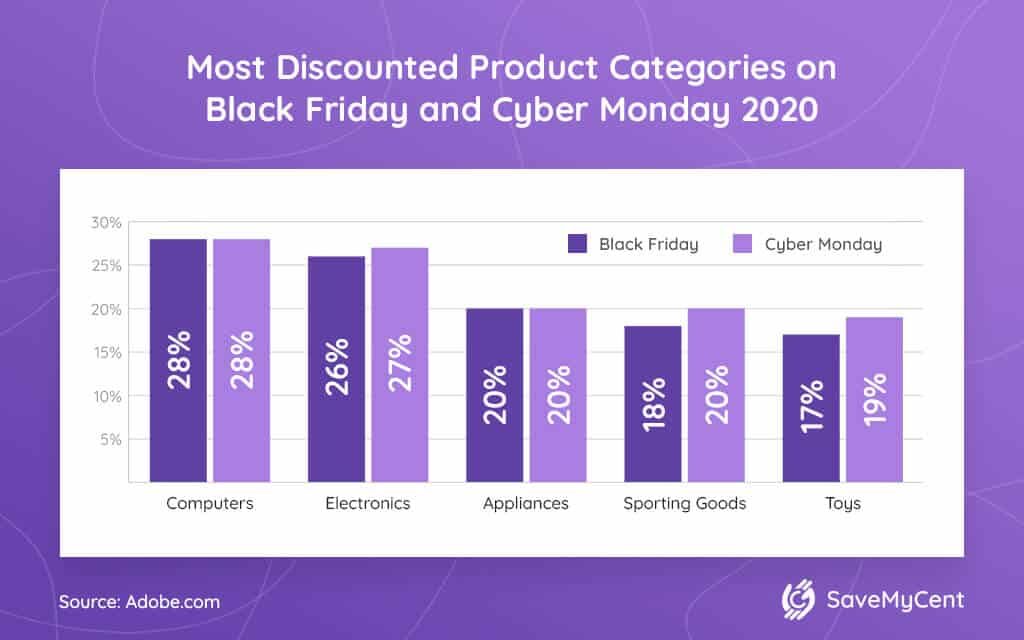
Meanwhile, the Cyber Monday discounts on electronics were more generous at 27%. As for other categories, sporting goods and appliances were discounted by 20% each, while the average discount on toys was 19%. Comparing Black Friday vs. Cyber Monday deals in 2020, the latter holiday fared slightly better overall — but the price reduction differences were minimal.
15. Most US consumers expected more generous Black Friday discounts in 2020.
(Statista)
Despite the record-high online discounts, Black Friday facts reveal most consumers expected retailers to lower their prices even more. According to a November 2020 survey, more than half of American shoppers (51%) hoped for markdowns in the 26%–50% range. What’s more, 21% expected price decreases of over 50%. On the other hand, 27% said they expected deals in the 10%–25% range, while only 2% assumed the average discount would be lower than 10%.
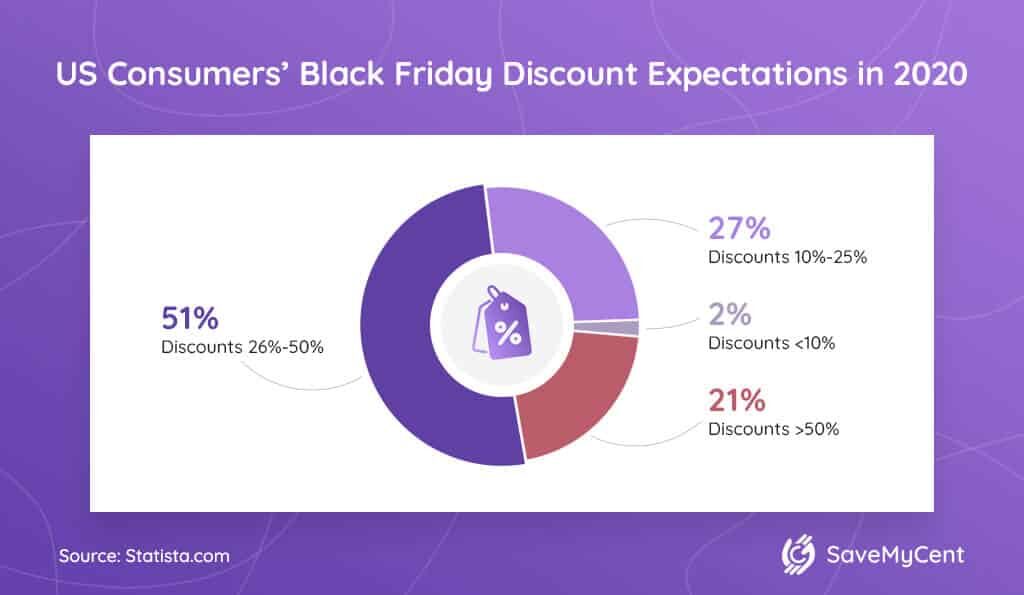
Black Friday vs. Cyber Monday Statistics: Shopping Trends
16. Millennials spend the most money during Black Friday sales.
(Finder, PYMNTS)
In a September 2020 survey, millennials reported they were planning to spend an average of $851.79 on Black Friday deals. This puts them far ahead of Gen-Xers ($679.18), Gen-Zers ($594.56), and baby boomers ($577.81) as the biggest spenders on this shopping holiday.
Looking at Black Friday statistics from 2019, an average millennial spent $509.50 on online shopping that year. That means their spending went up by an impressive 67.2%. A two-year Black Friday comparison reveals even more staggering results. Namely, in 2018, millennials were already leading the pack with an average of $382.40 spent per shopper. According to these numbers, their spending on Black Friday has increased by 122.7% over just two years.
17. 45% of Americans opted for online Cyber Weekend shopping in 2020.
(Forbes)
Black Friday was originally conceived as an in-store shopping event, while Cyber Monday deals were predominantly available online. But in 2020, there wasn’t a big difference between Black Friday and Cyber Monday, as 45% of Americans chose to shop exclusively online. Besides the convenience of online shopping, staying safe during the pandemic was the most cited reason for this decision. As a result, in-store visits during Black Friday dropped by 52% from 2019.
18. Laptops were the most popular product category during Cyber Weekend 2020.
(Semrush, Printful)
Whether we’re talking about Black Friday or Cyber Monday, most online shoppers looked for laptops in 2020. With 419,260 searches, they topped a Semrush survey of the categories most often searched along with the keyword “Black Friday.” Other popular search terms included “TV” (188,550 searches), “smart TV” (121,700), “microwave” (106,020), and “furniture” (100,890).
19. Gaming consoles were Cyber Weekend’s most searched products in 2020.
(Semrush)
Nintendo Switch (2.98 million searches) and PlayStation 4 (1.35 million) topped the list of the most searched products during Cyber Weekend 2020. In the electronics category — where the Cyber Monday discounts were better than those on Black Friday — Apple’s AirPods was the most popular item with 1.32 million searches. Other products shoppers actively looked up ahead of Cyber Weekend included the Apple Watch, the iPhone 11, iPads, and Vans sneakers.
20. Most US shoppers used their cards to pay for Black Friday purchases in 2020.
(PYMNTS, Finextra Research)
The majority of US consumers prefer using credit cards and debit cards to pay for purchases, and recent Cyber Weekend stats reflect that. In 2020, 48.6% of in-store shoppers and 40% of online shoppers paid with their debit cards on Black Friday. In addition, 45.1% used a credit card to pay for their in-store purchases, and 54% did the same for their online purchases. Digital wallets also made the list across both channels, with PayPal far ahead of its competitors.
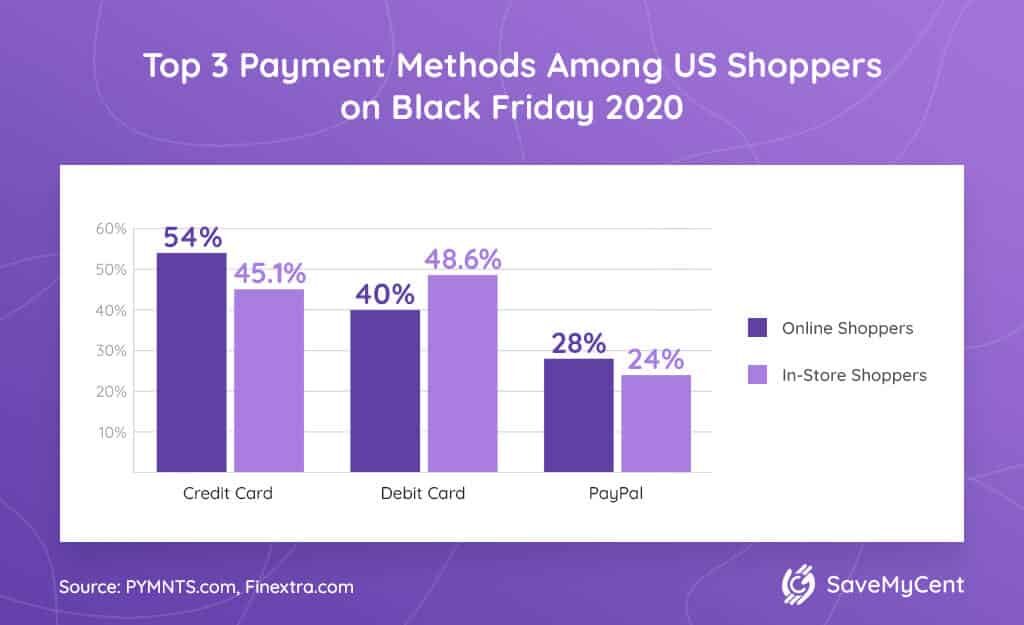
Be it Cyber Monday or Black Friday, more and more customers are opting for contactless payment. In fact, a recent survey found that 40% won’t buy from sellers who don’t accept digital wallets. Furthermore, 37% will not shop at a retailer that doesn’t accept contactless cards.
Cyber Monday vs. Black Friday Statistics: In Conclusion
Looking at Cyber Monday vs. Black Friday sales, the former is much more successful, at least online. In fact, experts predict that as more and more consumers start shopping online, Cyber Monday — a predominantly internet-based shopping holiday — will become more significant.
The statistics from 2020 back this prediction up. For one, Cyber Monday ended up raking in a much larger revenue, despite holiday deals being available for longer than any previous year. And although the discounts weren’t that different compared to Black Friday, a simple price comparison shows that the markdowns were still somewhat more generous on Cyber Monday.
Retailers are already preparing for the 2022 shopping season. With the pandemic still ongoing, they are focusing on digital sales channels, as many shoppers still don’t feel safe going to retail stores. How the upcoming season will fare is anyone’s guess at this point. But if 2020 has taught us anything, it’s that the industry and the customers are both very adaptable to changes.
FAQ
Why are Black Friday and Cyber Monday important?
Besides being the two biggest online shopping days, these two dates are important for a few other reasons. For one, research shows that US consumers are up to six times more likely to do their holiday shopping on these two days and the period around them. Also, ecommerce sites report an overall revenue increase of up to 240% on Black Friday and 380% on Cyber Monday.
When is the best time to shop on Black Friday?
Seeing as most retailers discount limited quantities of each item, it is best to shop as early in the day as possible. Whether online or in-store, most shoppers take advantage of the Black Friday deals during the morning hours. Before the COVID-19 pandemic hit, most stores would see high foot traffic during the opening hours (typically around 5 am) and between 2 pm and 5 pm. So the safest bet to avoid large crowds at brick-and-mortar stores is to shop between 7 am and 1 pm.
Are Cyber Monday deals the same as Black Friday?
Cyber Monday deals are usually not the same as Black Friday deals. In previous years, Black Friday had better in-store deals, while Cyber Monday discounts were primarily online-based. As for ecommerce sites, many have a rotating selection of deals, so items that are marked down on Black Friday might not be discounted on Cyber Monday and vice versa. Finally, some retailers organize Cyber Weekend as a series of one-day sales and publish calendars before the event.
Is Cyber Monday better than Black Friday?
Cyber Monday discounts in 2020 were somewhat deeper than those offered on Black Friday — at least online. For example, though the discount on computers averaged 28% on both days, Cyber Monday deals on electronics were more generous than the Black Friday deals in this category (27% vs. 26%). Similarly, Cyber Weekend 2020 saw toys discounted by 17% on Friday and 19% on Monday, while sporting goods went from 18% off on Friday to 20% off on Monday.
Are Amazon Cyber Monday deals better than Black Friday?
While there’s no official data to back this up, industry experts claim that Amazon is the only ecommerce platform with better Cyber Monday deals. However, the most lucrative bargains are reserved for Prime members. In recent years, Amazon has saved its best deals for Prime Day, a two-day event with significant markdowns across different product categories. Typically held in July, it was moved to October in 2020 to launch the company’s holiday deals season.
How much in sales does Cyber Monday generate?
For the last three years, Cyber Monday has consistently posted better results in online sales. In 2020, it generated $10.8 billion and became the most successful online shopping day in US history. For context, this marked a 15.1% increase from the $9.4 billion the event generated in 2019. Even more impressively, the sales revenue was up by 36.7% from $7.9 billion in 2018.
Is it better to shop on Cyber Monday?
As evidenced by recent Black Friday vs. Cyber Monday statistics, the latter has somewhat more lucrative online deals in most product categories. Toys, electronics, and sporting goods all saw more generous discounts on Cyber Monday. However, there wasn’t any difference in discounts for the other two most popular categories — computer equipment and household appliances. In these two cases, only the product selection may have varied between the two shopping events.
Sources:

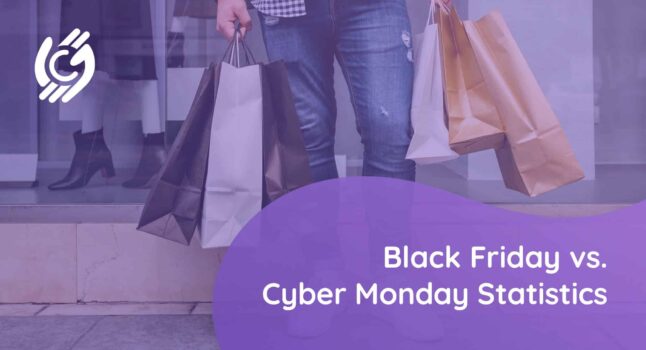





![How to Get Free Clothes From Shein? [2024 Guide]](https://savemycent.com/wp-content/uploads/2023/09/How-to-Get-Free-Clothes-From-Shein-336x220.png)
